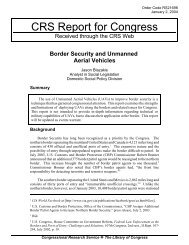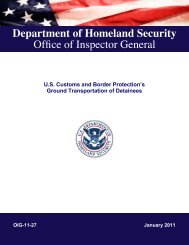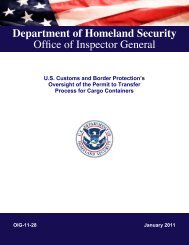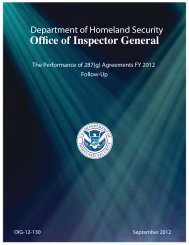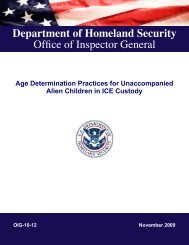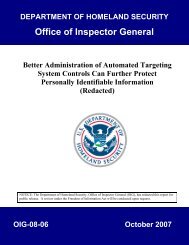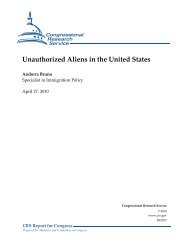<strong>Asylum</strong> <strong>and</strong> “<strong>Credible</strong> Fear” <strong>Issues</strong> <strong>in</strong> U.S. <strong>Immigration</strong> <strong>Policy</strong>this rationale <strong>in</strong> his April 17, 2003, rul<strong>in</strong>g that <strong>in</strong>structs EOIR immigration judges to consider“national security <strong>in</strong>terests implicated by the encouragement of further unlawful mass migrations...” <strong>in</strong> mak<strong>in</strong>g bond determ<strong>in</strong>ations regard<strong>in</strong>g release from detention of unauthorized migrantswho arrive <strong>in</strong> “the United States by sea seek<strong>in</strong>g to evade <strong>in</strong>spection.” 35 The case <strong>in</strong>volved aHaitian who had come ashore <strong>in</strong> Biscayne Bay, FL, on October 29, 2002, <strong>and</strong> had been releasedon bond by an immigration judge. The BIA had upheld his release, but the Attorney Generalvacated the BIA decision. 36Background ChecksAll foreign nationals seek<strong>in</strong>g asylum are subject to multiple background checks <strong>in</strong> the terrorist,immigration, <strong>and</strong> law enforcement databases. Those who enter the country legally onnonimmigrant visas are screened by the consular officers at the Department of State when theyapply for a visa, <strong>and</strong> all foreign nationals are <strong>in</strong>spected by CBP officers at ports of entry. 37 Thosewho enter the country illegally are screened by the U.S. Border Patrol or the ICE agents whenthey are apprehended. 38 When aliens formally request asylum, they are sent to the nearest USCISauthorizedf<strong>in</strong>gerpr<strong>in</strong>t site. They have all 10 f<strong>in</strong>gers scanned <strong>and</strong> are subject to a full backgroundcheck by the Federal Bureau of Investigation (FBI). 39Victims of TortureDist<strong>in</strong>ct from asylum law <strong>and</strong> policy, aliens claim<strong>in</strong>g relief from removal due to torture may betreated separately under regulations implement<strong>in</strong>g the United Nations Convention Aga<strong>in</strong>st Torture<strong>and</strong> Other Cruel, Inhuman or Degrad<strong>in</strong>g Treatment or Punishment (hereafter, TortureConvention). Article 3 of the Torture Convention prohibits the return of any person to a countrywhere there are “substantial grounds” for believ<strong>in</strong>g that he or she would be <strong>in</strong> danger of be<strong>in</strong>gtortured. The alien must meet the three elements necessary to establish torture:1. the torture must <strong>in</strong>volve the <strong>in</strong>fliction of severe pa<strong>in</strong> or suffer<strong>in</strong>g, either physicalor mental;2. the torture must be <strong>in</strong>tentionally <strong>in</strong>flicted; <strong>and</strong>3. the torture must be committed by or at the acquiescence of a public official orperson act<strong>in</strong>g <strong>in</strong> an official capacity.Generally, an applicant for non-removal under Article 3 has the burden of prov<strong>in</strong>g that it is morelikely than not that he would be tortured if removed to the proposed country. If credible, theapplicant’s testimony may be sufficient to susta<strong>in</strong> this burden without additional corroboration. 4035 23 I&N Dec. 572 (A.G. 2003).36 CRS Report RS21349, U.S. <strong>Immigration</strong> <strong>Policy</strong> on Haitian Migrants, by Ruth Ellen Wasem.37 For more <strong>in</strong>formation <strong>and</strong> analysis of alien screen<strong>in</strong>g <strong>and</strong> background checks, see CRS Report RL32564,<strong>Immigration</strong>: Terrorist Grounds for Exclusion <strong>and</strong> Removal of Aliens, by Michael John Garcia <strong>and</strong> Ruth Ellen Wasem;<strong>and</strong> CRS Report R41104, <strong>Immigration</strong> Visa Issuances <strong>and</strong> Grounds for Exclusion: <strong>Policy</strong> <strong>and</strong> Trends, by Ruth EllenWasem.38 CRS Report RL32562, Border Security: The Role of the U.S. Border Patrol, by Chad C. Haddal.39 For more <strong>in</strong>formation, see U.S. Citizenship <strong>and</strong> <strong>Immigration</strong> Services, Affirmative <strong>Asylum</strong> Procedures Manual,February 2003, pp. 93-144.40 8 C.F.R. §208.16(c)(2).Congressional Research Service 12
<strong>Asylum</strong> <strong>and</strong> “<strong>Credible</strong> Fear” <strong>Issues</strong> <strong>in</strong> U.S. <strong>Immigration</strong> <strong>Policy</strong>In assess<strong>in</strong>g whether it is “more likely than not” that an applicant would be tortured if removed tothe proposed country, all evidence relevant to the possibility of future torture is required to beconsidered. However, if a diplomatic assurance (deemed sufficiently reliable by the AttorneyGeneral or Secretary of State) that the alien will not be tortured is obta<strong>in</strong>ed from the governmentof the country to which the alien would be repatriated, the alien’s claim for protection will not beconsidered further <strong>and</strong> the alien may be removed. 41Source Countries for <strong>Asylum</strong> SeekersFor many years, most foreign nationals who sought asylum <strong>in</strong> the United States were from theWestern Hemisphere, notably Central America <strong>and</strong> the Caribbean. From October 1981 throughMarch 1991, for example, Salvadoran <strong>and</strong> Nicaraguan asylum applicants totaled over 252,000<strong>and</strong> made up half of all foreign nationals who applied for asylum with the INS. 42 In FY1995,more than three-fourths of asylum cases filed annually came from the Western Hemisphere. 43In FY1999, the People’s Republic of Ch<strong>in</strong>a (PRC) moved to the top of the source countries foraffirmative asylum claims, with 4,209 new cases. Somalia followed as a lead<strong>in</strong>g source countrywith 3,125 cases <strong>in</strong> FY1999. As the overall number of asylum seekers fell <strong>in</strong> the late 1990s, theshr<strong>in</strong>k<strong>in</strong>g numbers from Central America contributed to the decl<strong>in</strong>e. Simultaneously, the numberof asylum seekers from the PRC began ris<strong>in</strong>g <strong>and</strong> reached 10,522 affirmative cases <strong>in</strong> FY2002.The PRC rema<strong>in</strong>ed the lead<strong>in</strong>g source country throughout the 2000s.Top 10 Source Countries <strong>in</strong> FY2009<strong>Asylum</strong> seekers from the PRC dom<strong>in</strong>ated both the affirmative <strong>and</strong> defensive asylum caseloads <strong>in</strong>FY2009, as Figure 5 shows. They comprised 36% of the 24,550 affirmative cases filed withUSCIS <strong>and</strong> 24% of the 39,279 defensive cases filed with EOIR. Five of the top 10 sourcecountries of asylum seekers were Western Hemisphere nations <strong>in</strong> FY2009. The five were Haiti,Mexico, Guatemala, El Salvador, <strong>and</strong> Colombia. Ethiopia was the only African nation that was atop 10 source country for asylum seekers <strong>in</strong> FY2009.41 8 C.F.R. §208.18(c) <strong>and</strong> §1208(c). For a full legal analysis of the Torture Convention, see CRS Report RL32276, TheU.N. Convention Aga<strong>in</strong>st Torture: Overview of U.S. Implementation <strong>Policy</strong> Concern<strong>in</strong>g the Removal of Aliens, byMichael John Garcia.42 CRS Report 93-233, <strong>Asylum</strong> Seekers: Haitians In Comparative Context, by Ruth Ellen Wasem, (Archived, availableon request).43 CRS Report 94-314, <strong>Asylum</strong> Facts And <strong>Issues</strong>, by Ruth Ellen Wasem, (Archived, available on request).Congressional Research Service 13



